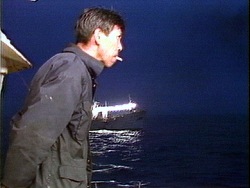Description
Viola writes: "I was thinking about light and its relation to water and to life, and also its opposite — darkness or the night and death. Video treats light like water — it becomes fluid on the video tube. Water supports the fish like light supports man. Land is the death of the fish — darkness is the death of man." Unfolding as a dreamlike trance, Hatsu Yume is a startlingly beautiful, metaphorical work. Viola fuses a personal observation of Japanese culture with a metaphysical contemplation of life, death and nature, achieved through a symbolic exploration of video's relation to light and reflection. Viola's vision of the Japanese culture and landscape evolves in a dramatic language of almost hallucinatory passages and vivid images. An immobile rock on a mountainside appears to change in size and scale with the shifting passage of time and light; an urban scene is illuminated by a single match; fishermen trawl on a black ocean at night, hauling in luminous squids using light as bait. Throughout, Viola creates haunting allegories of light as a metaphysical construct.
Recorded/Edited: Bill Viola. Production Assistant/Still Photographer: Kira Perov. With: Shinnosuke Misawa. Supervising Producer: Carol Brandenburg. Produced in association with Sony Corporation, Atsugi, Japan, and the TV Lab at WNET/Thirteen, New York.
Exhibition & Distribution Conditions
This work has been remastered to HD video by Bill Viola. The HD video is 16:9 aspect ratio, with black pillar bars on either side of the 4:3 image. This must be shown using a 16:9, HD display.
High-Definition Video Guide
SCREENING REQUIREMENTS for museum or gallery presentation:
The video should be presented as cinema. Projection in a dedicated, darkened gallery is strongly preferred. Accompanying floor plans and technical specifications regarding projection equipment is appreciated. Videos must be shown in original 4:3 aspect ratio, either using projector settings, as available, or pillarboxed with black masking.
Seating must be provided for the audience, and works must be shown according to a published schedule, not presented as an automatically repeating loop. Works cannot be incorporated into looping programs with other titles. Audio must be handled through a separate stereo sound system (amplifier and two speakers).
Please contact the EAI office (info@eai.org) for further information regarding monitor displays. Presentation on monitor may be permitted in certain instances, but the use of headphones or sound through built-in speakers is not permitted.
